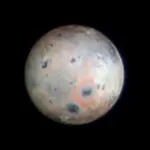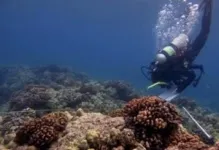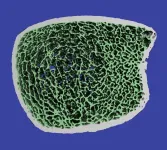(Press-News.org) New images of Jupiter's volcano-studded moon Io, taken by the Large Binocular Telescope on Mount Graham in Arizona, offer the highest resolution of Io ever achieved with an Earth-based instrument. The observations were made possible by a new high-contrast optical imaging instrument, dubbed SHARK-VIS, and the telescope's adaptive optics system, which compensates for the blurring induced by atmospheric turbulence.
The images, to be published in the journal Geophysical Research Letters, reveal surface features as small as 50 miles across, a spatial resolution that until now had been achievable only with spacecraft sent to Jupiter. This is equivalent to taking a picture of a dime-sized object from 100 miles away, according to the research team. SHARK-VIS allowed the researchers to identify a major resurfacing event around Pele, one of Io's most prominent volcanoes. According to the paper's first author, Al Conrad, the eruptions on Io, the most volcanically active body in the solar system, dwarf their contemporaries on Earth.
"Io, therefore, presents a unique opportunity to learn about the mighty eruptions that helped shape the surfaces of the Earth and the moon in their distant pasts," said Conrad, associate staff scientist at the Large Binocular Telescope Observatory. The Large Binocular Telescope, or LBT, is part of Mount Graham International Observatory, a division of the University of Arizona Steward Observatory.
Conrad added that studies like this one will help researchers understand why some worlds in the solar system are volcanic but not others. They also may someday shed light on volcanic worlds in exoplanet systems around nearby stars.
Slightly larger than Earth's moon, Io is the innermost of Jupiter's Galilean moons, which in addition to Io include Europa, Ganymede and Callisto. Locked in a gravitational "tug of war" among Jupiter, Europa and Ganymede, Io is constantly being squeezed, leading to frictional heat buildup in its interior – believed to be the cause for its sustained and widespread volcanic activity.
Jupiter moon Io, imaged by SHARK-VIS on Jan. 10, 2024. This is the highest resolution image of Io ever obtained by an Earth-based telescope. The image combines three spectral bands — infrared, red and yellow — to highlight the reddish ring around the volcano Pele (below and to the right of the moon's center) and the white ring around Pillan Patera, to the right of Pele.
By monitoring the eruptions on Io's surface, scientists hope to gain insights into the heat-driven movement of material underneath the moon's surface, its internal structure and ultimately, on the tidal heating mechanism responsible for Io's intense volcanism.
Io's volcanic activity was first discovered in 1979, when Linda Morabito, an engineer on NASA's Voyager mission, spotted an eruption plume in one of the images taken by the spacecraft during its famous "Grand Tour" of the outer planets. Since then, countless observations have been made that document Io's restless nature, from both space and Earth-based telescopes.
Study co-author Ashley Davies, a principal scientist at NASA's Jet Propulsion Laboratory, said the new image taken by SHARK-VIS is so rich in detail that it has allowed the team to identify a major resurfacing event in which the plume deposit around a prominent volcano known as Pele, located in Io's southern hemisphere close to the equator, is being covered by eruption deposits from Pillan Patera, a neighboring volcano. A similar eruption sequence was observed by NASA's Galileo spacecraft, which explored the Jupiter system between 1995 and 2003.
"We interpret the changes as dark lava deposits and white sulfur dioxide deposits originating from an eruption at Pillan Patera, which partially cover Pele's red, sulfur-rich plume deposit," Davies said. "Before SHARK-VIS, such resurfacing events were impossible to observe from Earth."
While telescope images in the infrared can detect hot spots caused by ongoing volcanic eruptions, they are not sharp enough to reveal surface details and unambiguously identify the locations of the eruptions, explained co-author Imke de Pater, professor emerita of astronomy at the University of California – Berkeley.
"Sharper images at visible wavelengths like those provided by SHARK-VIS and LBT are essential to identify both locations of eruptions and surface changes not detectable in the infrared, such as new plume deposits," de Pater said, adding that visible light observations provide researchers with vital context for the interpretation of infrared observations, including those from spacecraft such as Juno, which is currently orbiting Jupiter.
SHARK-VIS was built by the Italian National Institute for Astrophysics at the Rome Astronomical Observatory and is managed by a team led by principal investigator Fernando Pedichini, assisted by project manager Roberto Piazzesi. In 2023, it was installed, together with its complementary near-infrared instrument SHARK-NIR, at the LBT to fully take advantage of the telescope's outstanding adaptive optics system. The instrument houses a fast, ultra-low-noise camera that allows it to observe the sky in "fast imaging" mode, capturing slow-motion footage that freezes the optical distortions caused by atmospheric turbulence, and to post-process data to an unprecedented sharpness.
Gianluca Li Causi, data processing manager for SHARK-VIS at the Italian National Institute for Astrophysics, explained how it works: "We process our data on the computer to remove any trace of the sensor's electronic footprint. We then select the best frames and combine them using a highly efficient software package called Kraken, developed by our colleagues Douglas Hope and Stuart Jefferies from Georgia State University. Kraken allows us to remove atmospheric effects, revealing Io in incredible sharpness."
SHARK-VIS instrument scientist Simone Antoniucci said he anticipates new observations to be made of objects throughout the solar system.
"The keen vision of SHARK-VIS is particularly suited to observing the surfaces of many solar system bodies, not only the moons of giant planets but also asteroids," he said. "We have already observed some of those, with the data currently being analyzed, and are planning to observe more."
END
Glimpses of a volcanic world: New telescope images of Jupiter's moon Io rival those from spacecraft
Astronomers have captured a volcanic event on Jupiter's moon Io at a resolution never before achieved with Earth-based observations
2024-05-31
ELSE PRESS RELEASES FROM THIS DATE:
Wake Forest University School of Medicine awarded $1.5 million from NIH to use advanced imaging to assess bone loss after bariatric surgery
2024-05-30
WINSTON-SALEM, N.C. – May 30, 2024 – Researchers at Wake Forest University of School of Medicine have received a five-year, $1.5 million grant from the National Institute of Arthritis and Musculoskeletal and Skin Diseases, part of the National Institutes of Health (NIH), to study bone microarchitecture in patients following bariatric surgery.
With the funding support, researchers at Wake Forest University School of Medicine will partner with Virginia Tech to add a virtual biopsy that uses an innovative technique called high-resolution peripheral quantitative ...
Researchers identify factors that heighten risk for catheter-associated urinary tract infections and sepsis
2024-05-30
Urinary catheters are required for nearly every surgical procedure. However, a major challenge for the health care industry is predicting who may develop catheter-associated urinary tract infections (CAUTIs) and when these infections may lead to death.
Now, a study from the University of Notre Dame has identified a population that is more susceptible to developing a CAUTI.
Researchers showed that models with fibrinolytic deficiencies, or conditions that cause overactivation of the protein fibrin, had increased risk for developing severe and persistent CAUTIs. ...
How community stress affects Black Americans’ mental health and wellbeing
2024-05-30
URBANA, Illinois – Residential segregation is an example of the long history of structural racism in the United States. Black Americans are more likely to live in low-quality neighborhoods, which contributes to disparities in health outcomes. A new study from the University of Illinois Urbana-Champaign looks at how community stress affects the mental and emotional health of Black men and women in the U.S.
“Community stress refers to the effects of living in disadvantaged areas. This includes objective aspects, such as buildings ...
Every drop counts: New algorithm tracks Texas daily reservoir evaporation rates
2024-05-30
Summer can be an extra challenging time for Texas’ 189 major water supply reservoirs. With temperatures consistently reaching 100 degrees or higher, reservoir evaporation rates see high increases.
Accurate evaporation rate estimates are crucial for water resource managers, as reservoirs play an essential role in our social and economic systems by supplying water for agricultural, municipal, and industrial consumption. Reservoirs are also critical for mitigating impacts from droughts and floods.
A recent study published ...
Study: Access to targeted lung cancer drug is cost-prohibitive globally
2024-05-30
MIAMI, FLORIDA (May 30, 2024) – Many countries with national healthcare systems or payers such as insurance companies use cost-effectiveness analyses to decide whether to cover new medicines, balancing treatment costs with potential health benefits.
That strategy often limits access to new, targeted therapies, even when these drugs prove highly effective and become part of standard-of-care therapy for many patients.
A new study from Sylvester Comprehensive Cancer Center at the University of Miami Miller School of Medicine examined the cost-effectiveness of durvalumab, a targeted immunotherapy for lung cancer that ...
Insilico Medicine President Alex Aliper, Ph.D. to present at Systems Aging Gordon Research Conference
2024-05-30
Alex Aliper, PhD, president of global clinical stage artificial intelligence (AI)-powered drug discovery company Insilico Medicine (“Insilico”) will present at the Systems Aging Gordon Research Conference, a leading international scientific conference focused on advancing the frontiers of science through the presentation of cutting-edge and unpublished research. On Wed., June 5, 10:40 am, Dr. Aliper will give a talk titled "Generative Artificial Intelligence and Next-Generation Robotics for Drug Discovery and Longevity Research."
The conference ...
ESA announces recipients of 2024 Awards
2024-05-30
The Ecological Society of America is pleased to announce the winners of its 2024 awards, which recognize outstanding contributions to ecology in new discoveries, teaching, sustainability, diversity and lifelong commitment to the profession.
These awards are designed to not only reward past achievements, but also to inspire a broad audience of scientists, educators and students, opening the door to new insights and collaborations that will further the impact of ecological research.
“The Ecological Society of America is immensely proud to honor this year’s distinguished awardees,” said ESA President ...
Novel mobile air monitoring technology yields greater insight into post-disaster pollution levels
2024-05-30
A team including researchers from the Texas A&M University School of Public Health and School of Medicine has found that high resolution mass spectrometry could be a valuable tool for identifying and assessing air-borne contaminants produced by natural and man-made disasters. Their findings were published in the Journal of Exposure Science & Environmental Epidemiology.
The scientists used high resolution mass spectrometry—a highly accurate means of identifying molecular compounds in a sample—in fall 2023 to identify volatile organic ...
Human cervix modeled in microfluidic organ chip fills key women's health gap
2024-05-30
Human cervix modeled in microfluidic organ chip fills key women's health gap
Engineered cervix with in vivo-like mucus production, hormone sensitivity, and associated microbiome creates novel testbed for bacterial vaginosis therapeutics and other treatments
By Benjamin Boettner
(BOSTON) — Bacterial Vaginosis (BV) has been identified as one of the many unmet needs in women's health and affects more than 25% of reproductive-aged women. It is caused by pathogenic bacteria that push the healthy microbiomes in the female vagina and cervix – the small gatekeeper canal that connects the uteruns and vagina – into a state of imbalance known as dysbiosis. ...
People are altering decomposition rates in waterways
2024-05-30
Humans may be accelerating the rate at which organic matter decomposes in rivers and streams on a global scale, according to a new study from the University of Georgia, Oakland University and Kent State University.
That could pose a threat to biodiversity in waterways around the world and increase the amount of carbon in Earth’s atmosphere, potentially exacerbating climate change.
Published in Science, the study is the first to combine a global experiment and predictive modeling to illustrate how human impacts to waterways may contribute to the global climate crisis.
“Everyone in the world needs water,” ...
LAST 30 PRESS RELEASES:
Correlation between cancer cachexia and immune-related adverse events in HCC
Human adipose tissue: a new source for functional organoids
Metro lines double as freight highways during off-peak hours, Beijing study shows
Biomedical functions and applications of nanomaterials in tumor diagnosis and treatment: perspectives from ophthalmic oncology
3D imaging unveils how passivation improves perovskite solar cell performance
Enriching framework Al sites in 8-membered rings of Cu-SSZ-39 zeolite to enhance low-temperature ammonia selective catalytic reduction performance
AI-powered RNA drug development: a new frontier in therapeutics
Decoupling the HOR enhancement on PtRu: Dynamically matching interfacial water to reaction coordinates
Sulfur isn’t poisonous when it synergistically acts with phosphine in olefins hydroformylation
URI researchers uncover molecular mechanisms behind speciation in corals
Chitin based carbon aerogel offers a cleaner way to store thermal energy
Tracing hidden sources of nitrate pollution in rapidly changing rural urban landscapes
Viruses on plastic pollution may quietly accelerate the spread of antibiotic resistance
Three UH Rainbow Babies & Children’s faculty elected to prestigious American Pediatric Society
Tunnel resilience models unveiled to aid post-earthquake recovery
Satellite communication systems: the future of 5G/6G connectivity
Space computing power networks: a new frontier for satellite technologies
Experiments advance potential of protein that makes hydrogen sulfide as a therapeutic target for Alzheimer’s disease
Examining private equity’s role in fertility care
Current Molecular Pharmacology achieves a landmark: real-time CiteScore advances to 7.2
Skeletal muscle epigenetic clocks developed using postmortem tissue from an Asian population
Estimating unemployment rates with social media data
Climate policies can backfire by eroding “green” values, study finds
Too much screen time too soon? A*STAR study links infant screen exposure to brain changes and teen anxiety
Global psychiatry mourns Professor Dan Stein, visionary who transformed mental health science across Africa and beyond
KIST develops eco-friendly palladium recovery technology to safeguard resource security
Statins significantly reduce mortality risk for adults with diabetes, regardless of cardiovascular risk
Brain immune cells may drive more damage in females than males with Alzheimer’s
Evidence-based recommendations empower clinicians to manage epilepsy in pregnancy
Fungus turns bark beetles’ defenses against them
[Press-News.org] Glimpses of a volcanic world: New telescope images of Jupiter's moon Io rival those from spacecraftAstronomers have captured a volcanic event on Jupiter's moon Io at a resolution never before achieved with Earth-based observations









